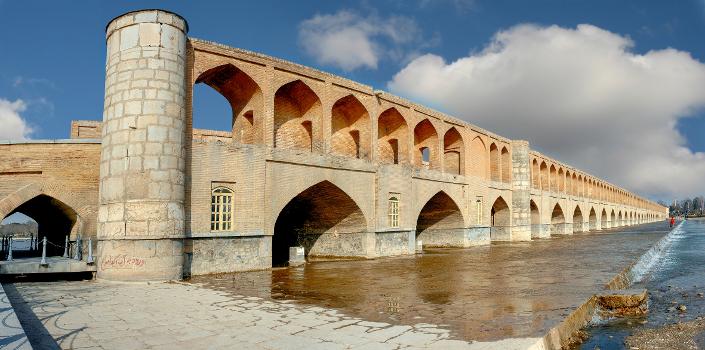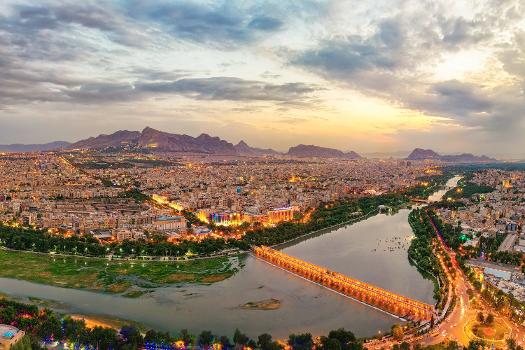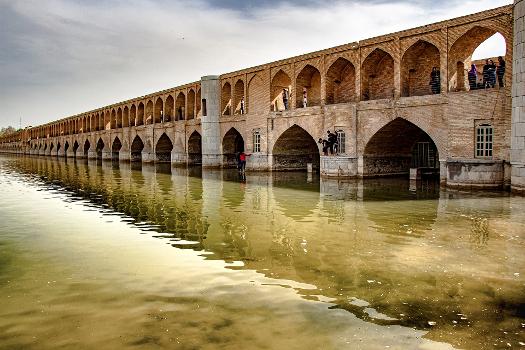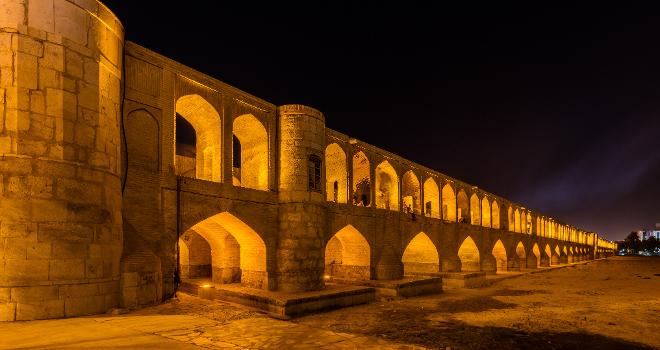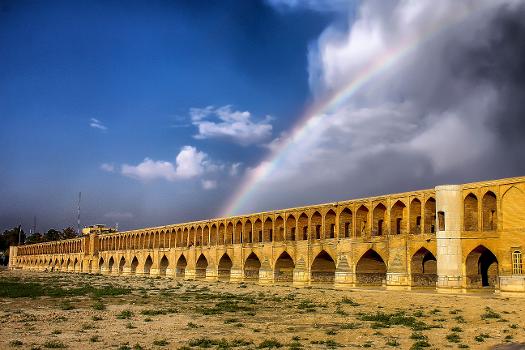General Information
| Name in local language: | پل اللهوردی خان (Si-o-se Pol) |
|---|---|
| Other name(s): | Bridge of 33 Arches |
| Beginning of works: | 1599 |
| Completion: | 1602 |
| Status: | in use |
Project Type
| Structure: |
Pointed arch bridge |
|---|---|
| Function / usage: |
Road bridge |
| Material: |
Masonry bridge |
| Plan view: |
Structurae Plus/Pro - Subscribe Now! |
| Material: |
Structurae Plus/Pro - Subscribe Now! |
Location
Technical Information
Dimensions
| width | 13.75 m | |
| total length | 297.76 m | |
| arch span | 5.60 m | |
| number of arches | 33 |
Materials
| piers |
stone
|
|---|---|
| arches |
stone
|
Excerpt from Wikipedia
The Allahverdi Khan Bridge (Persian: پل اللهوردی خان), popularly known as Si-o-se-pol (Persian: سیوسهپل, lit. '[the] bridge of thirty-three [spans]'), is the largest of the eleven historical bridges on the Zayanderud, the largest river of the Iranian Plateau, in Isfahan, Iran.
The bridge was built in the early 17th century to serve as both a bridge and a dam. It is a popular recreational gathering place, and is one of the most famous examples of Iran's Safavid architecture.
History
Si-o-se-pol was built between 1599 and 1602, under the reign of Abbas I, the fifth Safavid king (shah) of Iran. It was constructed under the supervision of Allahverdi Khan Undiladze, the commander-in-chief of the armies, who was of Georgian origin, and was also named after him. The bridge served particularly as a connection between the mansions of the elite, as well as a link to the city's vital Armenian neighborhood of New Julfa.
Structure
The bridge has a total length of 297.76 metres (976.9 ft) and a total width of 14.75 metres (48.4 ft). It is a vaulted arch bridge consisting of two superimposed rows of 33 arches, from whence its popular name of Si-o-se-pol comes, and is made of stone. The longest span is about 5.60 metres (18.4 ft). The interior of Si-o-se-pol was originally decorated with paintings, which were often described by travelers as erotic.
There is a larger base plank at the start of the bridge, under which the Zayanderud flows, supporting a tea house, which is nowadays abandoned.
Text imported from Wikipedia article "Si-o-se-pol" and modified on December 29, 2021 according to the CC-BY-SA 4.0 International license.
Participants
Currently there is no information available about persons or companies having participated in this project.
Relevant Web Sites
Relevant Publications
- (2002): Bridges that Changed the World. Prestel, Munich (Germany), pp. 56-57.
- (2002): Brücken, die die Welt verbinden. Prestel, Munich (Germany), pp. 56-57.
- (1990): Les grands ponts du monde: Hors d'Europe. Brissaud, Poitiers (France), pp. 204.
- (1999): Tierra sobre el agua. Visión histórica universal de los puentes. Colegio de Ingenieros de Caminos, Canales y Puertos, Madrid (Spain), pp. 150.
- (1998): پل هاي قديمي ايران [Pol-ha-ye Qadimi-e Iran]. Ancient Bridges of Iran. Iranian Cultural Heritage Organization (سازمان میراث فرهنگي، صنايع دستي و گردشگري), Tehran (Iran), pp. 17.
- About this
data sheet - Structure-ID
20001774 - Published on:
19/08/2001 - Last updated on:
04/01/2025

